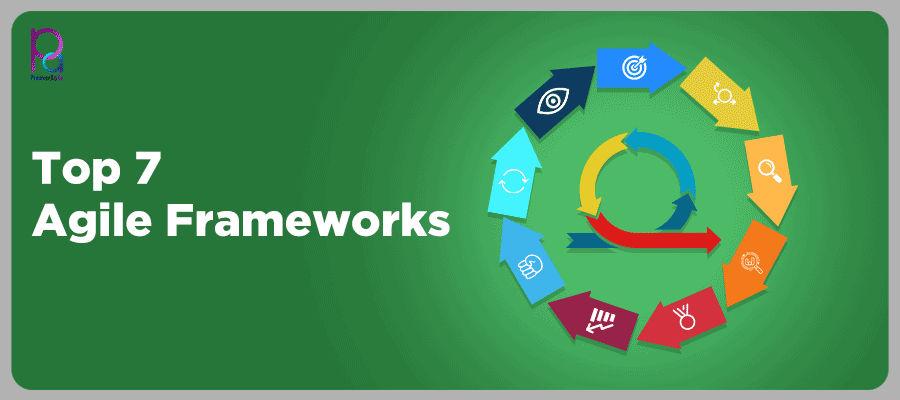Top 7 Agile Frameworks

Scrum is one of the most popular Agile frameworks. But, over the last few years, there are other Agile frameworks to develop products and services, creating a need to choose the one that suits you the most. As of the current day, there are more than fifty different Agile frameworks. Let us discuss a few major ones today.
In case you’re new to Agile then you must learn that Agile is a type of project management philosophy that is incremental & iterative based on its approach. The primary area where Agile is utilized is in software development. But, in the modern world, Agile can be applied to any organization of any industry.
Agile is different from the traditional waterfall approach and therefore is highly responsive to feedback & change.

Different Agile frameworks
1. Kanban
A type of Agile framework that has originated from the Japanese language, the word ‘Kanban’ means a signboard or a visual board. The Kanban concept is connected to the Just In Time methodology. Back in the day, Kanban was primarily introduced as a Lean Manufacturing System, and then it was slowly introduced into Agile software development procedures. The Kanban framework uses visual elements for managing & developing projects.
Projects that are created with Kanban are overseen by the Kanban Board. The Kanban Board is divided into multiple columns to properly depict the process flow for the development of software. Such a process helps in enhancing the visibility among the team members because each team member can see what is happening and what isn't so that they prepare themselves for the upcoming task for final delivery of the product. It should be known this method will require thorough transparency as well as interaction between the team members so that proper development of the product can take place.
Kanban works on the three following principles:
- Visualizing the work that is to be performed at any given time.
- Creating boundaries regarding the amount of work that is to be done or completed, so that the team doesn't over-commit additional work.
- Boosting workflow when a specific task is about to be completed so that the next item can be added to the queue.
2. Scrum
Scrum is one of the most popular Agile frameworks out there. However, unlike Kanban, Scrum focuses on breaking down a single project into multiple parts, known as 'Sprints', where only one Sprint will be planned & managed at a time. Scrum also includes unique project roles such as Product Owner, Scrum Master, and Developers.
Scrum generally utilizes a Scrum Board, which is similar to the Kanban Board, and thereby group various tasks into multiple columns based on their overall progress.
The process of the Scrum framework is as follows:
- The Product Owner will create an estimated wish list, which will be identified as the Product Backlog.
- The Scrum Team will take a few items from the top of the list and makes a plan how to turn them into product Increments; thereby denote it as the Sprint Backlog. The team will then work towards completing the current Sprint Backlog.
- The daily progress of the work will be synchronized via a meeting known as Daily Scrum.
- The Scrum Master will be responsible for maintaining the focus of the team.
- At the end of each Sprint, the Increments will be reviewed and feedback will be provided before the next Sprint is initiated.
3. Lean
Most people out there tend to mistake Lean with Agile (and vice versa), but it should be known that Lean is one of the many Agile framework types. Even though both are quite similar in terms of features, they're not the same thing. Lean is an abbreviation for Lean Manufacturing, which includes a specific set of managerial principles that the Japanese developed during the 20th century so that efficiency & value can be ensured in production. On the other hand, the Agile Manifesto was created in the year 2001.
The primary principles of Lean manufacturing are:
- Value stream mapping.
- Identifying value.
- Creating a pull system.
- Creating a continuous workflow.
- Continuous improvement.
All of the above-mentioned principles were later assimilated into one of the most popular Agile frameworks, known as Lean Software Development. The concept of Lean was then broken down into the following set of simple principles:
- Deliver fast.
- Eliminate waste.
- Have respect for people.
- Create knowledge.
- Build quality.
- Optimization.
- Always defer commitment.
With the help of Lean, businesses are encouraged to eliminate any procedure that hinders organization progress and only maximize the strategies that tend to work ideally for a given plan. For instance, to 'eliminate waste' an organization will cut down on time-consuming meetings, useless documents, and unproductive tasks that don't contribute towards productivity. Furthermore, Lean also stresses the importance of employees and they should collectively function together. Hence, respect for the employees or workers should be paramount because every person in a team of employees should know his or her role. As a result, each employee can trust the other.
4. DSDM or Dynamic Systems Development Method
DSDM was created out of sheer necessity when the entire software industry required an Agile framework that can help in delivering software rapidly. In DSDM, rework is expected to happen on the product after delivery and any additional development work that’s done should be reversible. Similar to Scrum, DSDM also uses the concept of Sprints.
The DSDM framework follows the below-mentioned set of principles:
- Show control: You must ensure the project stays on track with clear goals and accountability.
- Focus on the business requirements: Always prioritize delivering features that bring the most value to your business.
- Collaborate: Work closely with your team and stakeholders to keep everyone aligned.
- Consistently deliver on time: Stick to deadlines to maintain trust and keep the project relevant.
- Develop iteratively: Keep improving the product step by step, using feedback as you go.
- Don’t compromise on quality: Ensure every delivery meets high standards, no matter what.
- Build great foundations: Start with a solid plan to make everything else smoother later on.
- Always communicate clearly & continuously: Keep everyone informed with open and frequent communication.
5. XP or Extreme Programming
Extreme Programming is one of the foremost Agile frameworks out there. In this procedure, both the Developers and customers should exhibit a high degree of participation. The customers will be responsible for inspiring additional development of a product by showcasing the most useful features, via multiple testimonials. On the other hand, the Developers will base every set of software updates according to the feedback received from the customer while also testing new innovative features every few weeks.
It should be learned that XP has its share of benefits & drawbacks. On the meritorious side, XP will always involve a higher level of collaboration along with a very minimal amount of documentation. Moreover, it's a persistent & efficient delivery model.
Alternatively, when talking about the demerits of XP, it should be known that this procedure needs proper discipline and involvement from all parties, to make it successful. Additionally, XP works the best for smaller teams in general that have Developers who are highly skilled & experienced, combined with a proven track record in management & communication.
The XP method follows the below-mentioned set of principles:
- Simplicity.
- Uniformity.
- Endurance.
- Communication.
- Feedback.
6. FDD or Feature Driven Development
Feature-driven development (FDD) is a unique approach to Agile that focuses on delivering tangible results through well-defined features. If your team likes to see progress quickly and prefers structured, step-by-step processes, FDD is the methodology it needs.
In FDD, the development revolves around creating specific software models every two weeks. These models aren’t just rough sketches—they’re detailed enough to guide your design and development process effectively. While FDD requires rigorous documentation (more than methodologies like Extreme Programming), this added structure ensures that every feature is well-planned and executed. If your team thrives on advanced planning and design, FDD can help you achieve outstanding results.
Here’s a quick breakdown of the FDD steps to keep things clear:
- Develop an overall model: Start by mapping out a high-level system representation.
- Create a feature set: Break down the system into smaller, actionable features.
- Plan by feature: Organize the workflow around these features to prioritize effectively.
- Build by feature: Develop each feature, one step at a time, ensuring quality at every stage.
- Design by feature: Pay close attention to each feature’s design before moving on.
FDD works exceptionally well for teams that need a structured, predictable workflow. However, strong collaboration and communication are required to ensure that features align with the overall project vision.
7. Crystal
Crystal is an Agile framework that’s as flexible as it is people-focused. Crystal could be your go-to methodology if you’re part of a team that thrives on strong communication and collaboration. What sets Crystal apart is that it isn’t one-size-fits-all. Instead, it offers different "flavors" of frameworks based on team size, like:
- Crystal Clear: Perfect for small teams of up to 8 members.
- Crystal Yellow: Ideal for slightly larger teams of 10-20 members.
- Crystal Red: Designed for medium-sized teams of 20-50 members.
- Crystal Orange: Best for large teams ranging from 50 to 1,000 members.
What makes Crystal stand out? It’s all about people. This methodology emphasizes talent, skills, and interactions over rigid processes. The idea is simple. The results will be better when your team communicates effectively and reflects regularly.
Crystal also encourages constant adaptation. If something’s not working, you pivot, reflect, and improve. However, here’s the catch: if your team is distributed across different locations and can’t maintain regular communication, Crystal might not work for you. The framework thrives on face-to-face interactions and shared understanding, which are challenging to achieve with scattered teams.
In a nutshell, Crystal is all about building a community within your team and ensuring that everyone works together harmoniously to deliver top-notch software. If you have the right conditions—close-knit teams and strong communication—it’s a framework that can take your project to the next level.
Compared to the different types of Agile frameworks mentioned above, traditional project management procedures have always been linear, making them predictable & slow. As a result, they have limitations such as slow response to market change. That’s where Agile frameworks came as a saving grace.
Even though Agile project management procedures are new to the current market (compared to traditional ones), they're still highly dynamic and adaptable to market alterations. Agile has helped in shortening development timelines, enhancing productivity, and thereby empowering teams to create magnificent products.
References
- https://www.wrike.com/project-management-guide/faq/what-are-the-different-types-of-Agile-methodologies/
- https://www.analyticssteps.com/blogs/7-types-Agile-methodologies
- https://www.itbriefcase.net/7-different-types-of-Agile-methodologies




